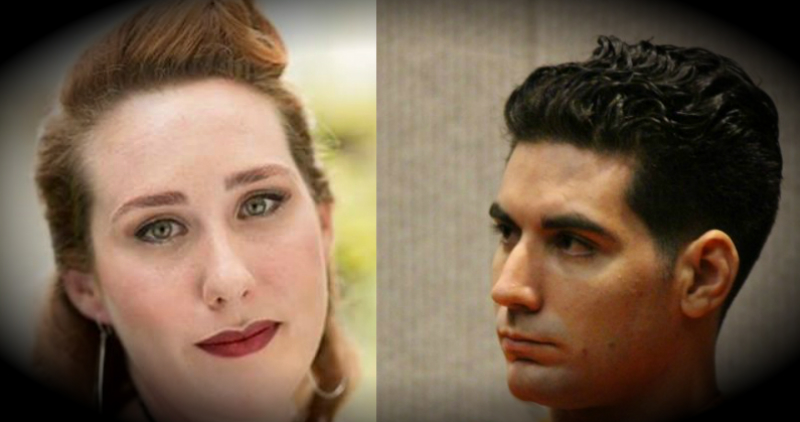Capobianco Trial: OB/GYN Reviews Sonogram Images of Fetus

Maui Chief Judge Joseph Cardoza is overseeing the murder trial (6.27.16) Photo by Wendy Osher.
A Maui Obstetrician-Gynecologist who treated Carly “Charli” Scott during her pregnancy testified as an expert witness in the field of medicine on Tuesday in the ongoing murder trial of Steven Capobianco.
Capobianco is standing trial for the murder of his pregnant ex-girlfriend Carly “Charli” Scott. He has pleaded not guilty to the charges. Scott was 27-years-old and five months pregnant with a child fathered by Capobianco when she went missing in February of 2014.
Stacy Renee Ammerman, a private practice OB/GYN at Maui Lani Physicians and Surgeons said she saw Scott twice in her office as a patient on: Jan 15, 2014 and Jan 27, 2014.
Education/Training/Experience:
Ammerman attended San Diego State University from 1999-2003; attended medical school in Pennsylvania at Lake Eerie College in Osteopathic Medicine from 2003-2007; and did her OBGYN residency at Harbor UCLA in Torrance, CA from 2007-2011.
She was licensed in CA during her entire residency and kept that license for approximately one year after moving to Maui. After that, she did not plan to return to California, and said she only maintains her Hawaiʻi license now, which she obtained in 2011.
Ammerman is also board certified in OBGYN. She published a study that she did during residency on heavy uteral bleeding and the treatment of it, a paper that was subject to peer review.
According to her testimony, Ammerman sees patients about three full days in the clinic, and sees approximately 30 patients per day. In addition, she also has surgical days in the operating room, and also delivers patients at Maui Memorial Medical Center.
Anatomy Scan Ordered: Images Indicate Live Fetus
Dr. Ammerman said she recalls Scott’s first visit on Jan. 15, 2014 saying, “I do remember her because she is quite tall, such as myself and she presented to the office with another female and we discussed her pregnancy.” In describing Scott’s demeanor, Ammerman said, “She seemed calm, normal, not in any distress or anxious by any means.”
“She had been referred by her primary care after having a confirmed pregnancy test in their office. She was approximately 18 weeks along by her last menstrual period due date,” said Dr. Ammerman, noting that’s how the pregnancy was calculated.
“Now-a-days, most physicians use an app on their phone to calculate it, but it can be calculated by taking (the first day of) their last menstrual period, adding a year, subtracting three months, adding seven days for a period of approximately 280 days, and that would be the length of a normal pregnancy,” said Ammerman.
During the initial exam, Dr. Ammerman said she ordered additional testing as a follow up saying, “Most women, when they present early in pregnancy, I actually perform an ultrasound in the office to confirm dating. Because she was a little bit later, and at the point where we would order what’s called an anatomy scan to assess the fetus, I ordered an ultrasound two days later at Maui Diagnostic Imaging to be performed,” Ammerman said.
According to testimony, nearly 50 images were taken during the anatomy scan, which includes multiple images of the fetus to assess growth, size, as well as pictures of the heart, brain, face, pallet, gender and extremities to ensure that everything looks normal. “Usually, if patients desire, they can find out the gender of the fetus at that visit. Those images go to the radiologist who then reads the images and creates a report, which I receive in my office,” said Dr. Ammerman.
Defense attorney Jon Apo asked how Ammerman ensures that accurate procedures are being done by the radiologist. Dr. Ammerman responded saying, “I don’t work at Maui Diagnostic Imaging. I rely on them as colleagues for information for my patients. I can’t tell you exactly what happens step by step when the patient goes to Maui Diagnostic Imaging, but I do trust their reports and haven’t had any issues to date with them.”
Dr. Ammerman showed jurors an sonogram image of the fetus and explained that it served as documentation of the fetal heart to document that there was a live fetus.
On the date of the ultrasound, Dr. Ammerman said the gestational age of Scott’s baby was 19 weeks and 3 days based on the ultrasound dating, or 19 weeks and 1 day based on the menstrual calculations.
In discussing the gender shot, Dr. Ammerman noted that Scott was going to have a boy. “Most women do want to know what they’re having. An occasional few don’t. Carly for instance wanted to do what’s called a gender reveal party where the ultrasound tech puts the gender in an envelope and they discover that later,” she said.
Dr. Ammerman noted that the dating using both menstrual period calculations and sonogram imaging was within two days of each other, providing confirmation that the original calculation was an accurate estimation. “The due date by her last menstrual period was June 12, 2014. The date by the ultrasound that was performed on Jan. 17, 2014 was June 10, 2014,” Ammerman said.
Just Over Half-Way Through Pregnancy, Visibly Pregnant:
During a follow up appointment on Jan 27, 2014, Ammerman said Scott was in her second trimester at 20 weeks and 4 days pregnant, or just over half-way through her pregnancy. “She was visibly pregnant,” said Dr. Ammerman.
“One of our assessments we do in addition to fetal heart tones at the visit is called a fundal height measurement, which we start doing at 20 weeks. We measure from the top of the pubic symphysis to the uterine fundus in centimeters and she was measuring 20 weeks,” Ammerman testified.
“That measurement should correspond plus or minus a week or two within centimeters. So she was measuring exactly 20 cm, which correlates to 20 weeks; and of course we knew she was 20 (weeks) and 4 (days) at that time,” said Dr. Ammerman, noting that, “Definitely by 20 weeks a woman is visibly pregnant.”
Scott was scheduled for a follow up appointment toward the end of February 2014, approximately four weeks after the Jan 27, 2014 visit.
Sonogram Shows Low-Lying Placenta:
“There was something on it (the sonogram) that needed follow up that we were going to schedule a second ultrasound for,” said Dr. Ammerman. The second ultrasound would have been done at around 28 weeks. On cross exam, Dr. Ammerman explained, “We did find the fact that her placenta was sitting low on the ultrasound, which requires follow up.”
She noted that at 19 weeks, it is “common to see it low-lying at that time because the uterus is smaller. As the uterus expands, placentas will most commonly move away. Not that many women will continue to have a low-lying or previa as they get to term,” said Ammerman.
Apo then asked what potential implications were of a low-laying placenta. Dr. Ammerman responded, “It’s seen commonly in anatomy scans in the second trimester. As the uterus expands, typically, the placenta moves away, along with the uterus. If the placenta remains low-lying, or if it’s completely covering the cervical os we call that placenta previa. If that is the issue, patients require a Cesarean Section for delivery because of the risk of hemorrhage during vaginal delivery.”
Apo also asked what some of the potential symptoms or effects pf a low-laying placenta would be on the pregnant woman. Ammerman responded saying, the majority of women are a-symptomatic and wouldn’t have too many symptoms. “One possible symptom that we would see, and we see more commonly in previa patients is vaginal bleeding,” which she said can present itself during sexual intercourse. She also noted that bleeding is seen “much more commonly in the first trimester rather than the second trimester.”
When asked if there were any habits or lifestyle choices that can contribute to having a low-lying placenta, Judge Joseph Cardoza sustained an objection raised by the prosecution. Another question concerning what kind of information is asked of patients, “including for example illegal drug use,” Judge Cardoza also sustained an objection relating to relevance. A subsequent question about the correlation between a low-lying placenta and sexual intercourse was also not answered due to objections raised.
Relative to that vaginal bleeding, Apo asked, “So I take it that between her last visit and when she went missing, you have no idea whether she had experienced any bleeding such as what we talked about?”
Ammerman responded saying, “No, but at the end of every visit, I discuss pre-term labor precautions with my patients, which includes bleeding, and inform them to call the office or to come to the emergency department or the hospital if they experience any of those symptoms.”
On redirect, the prosecution asked if there were any follow reports made by Scott regarding bleeding, and Ammerman said, “No. I would know if she went to the emergency room.”
On re-cross exam, Apo asked, “Would it be fair to say that you have no guarantees relative to Charli Scott or any patient following your recommendations. You don’t know if she followed your advice or not, right?” An objection was over-ruled and Dr. Ammerman responded saying, “I can only give my recommendations to patients. What they do outside of my office or the hospital is up to them.”
When asked about intermediary care regarding the low-lying placenta, Dr. Ammerman said, “Because it was low-lying and like I said, it was more than a centimeter, I believe 1.4 cm to be exact, I wouldn’t have given her any restrictions on sexual activity like I would have if she had a placenta that was covering the cervical os or touching the cervical os.”
“Unless I told her she had the condition, she would not know it was there,” said Ammerman in explaining the asymptomatic.
A Haʻikū, Maui man who helped police find the missing doors to Scott’s burned vehicle also testified on Tuesday. Testimony also continued from Maui Police Department evidence specialist Anthony Earls.
The trial is set to resume on Wednesday, Sept. 28, 2016, in 2nd Circuit Court before Maui Chief Judge Joseph Cardoza.

Charli Scott (left) courtesy photo; Steven Capobianco (right) by Wendy Osher (May 2016).
Case History/Background:
Steven Capobianco is standing trial for the murder of his pregnant ex-girlfriend, Carly “Charli” Scott. He is also accused of setting her vehicle on fire.
Scott was 27-years-old and five months pregnant at the time with an unborn child fathered by the defendant. Capobianco has pleaded not guilty to the charges.
In the days following Charli Scott’s disappearance, Capobianco had done an interview with police in which he said Scott had picked him up on the night of Sunday, Feb. 9, 2014, and dropped him off at his truck that got stuck in Keʻanae on Feb. 8, 2014.
According to the account, both headed back to Haʻikū, with Scott following Capobianco in case his vehicle broke down again. Scott was reported missing the next night on Feb. 10, 2014, after she failed to show up for work and did not return phone calls and messages from her family members.
On Friday, a forensic entomologist testified about the recovery of maggots from Nuaʻailua Bay, and provided an estimate on the possible time of death. This week, testimony continues on police processing of evidence.







_(2)_1750879698184.webp)
